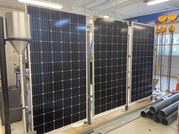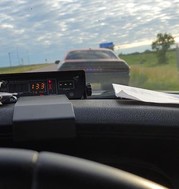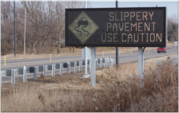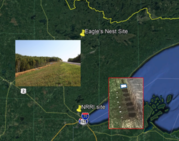|
Transportation Research Update


ENVIRONMENTAL — A research team examined the possibility of adding photovoltaic panels to MnDOT and local agency structures in the highway right of way to generate electricity that could offset installation costs and eventually generate revenue for other purposes. Team members designed and constructed a prototype system combining a noise barrier and a snow fence with solar panels. Laboratory testing and computer modeling indicated positive results in terms of safety, performance and cost–benefit analysis. Researchers propose constructing a quarter mile field project in northern Minnesota to further test the system.
Report 2021-20
|

TRAFFIC & SAFETY — The COVID-19 pandemic resulted in fewer drivers on Minnesota’s roads, but also more speeding and other unsafe behavior. Quantifying these behaviors should help Minnesota’s transportation agencies plan effective countermeasures. Researchers analyzed vehicle volume and speed data from 27 automated traffic recording (ATR) stations and 68 traffic sensor stations from March through December 2020. They compared this information to data from the previous year as well as work zone information from the Minnesota state highway construction projects list and citation rates, and interviews with Minnesota law enforcement. Traffic volumes were lower in 85% of ATR sites and all sensor sites. Speeds were higher overall but varied by month, with speeds in July and April reaching nearly 3% higher. Speeding-related crashes were 2% to 5% higher in five districts, and speeding-related crashes that resulted in serious injuries or fatalities increased 4% to 13% in four districts.
Report 2021-21
|

TRAFFIC & SAFETY — Do real-time displays of winter road conditions actually impact driver behavior? While regular road maintenance, snowplowing and a well-trained workforce are crucial for winter road safety, driver behavior is the last defense against crashes and many other traffic hazards. Researchers found that speeds can, in fact, decrease in some cases as a result of displayed road condition warnings. They used road friction sensors that detected adverse road conditions and traffic sensors before and after dynamic message signs (DMS) displaying road condition warnings. The traffic sensor data identified speed changes and car following distances. Many factors, however, impact DMS effectiveness. Urban or rural roads, routine maintenance practices on roads and the severity of storm events impact how effective the warnings are in slowing drivers down. MnDOT can use information from this project to strategically and cost-effectively place DMS across the state.
Report 2021-25
|

ENVIRONMENTAL — Bioslopes are among the methods MnDOT uses to control roadway stormwater runoff. Engineered bioslopes slope down from the roadway and mimic the natural landscape. They use special filtration media such as new compost and sand, which is trucked into road construction sites. This filter media holds and slowly filters rainwater, and retains nutrients and other pollutants. In a previous study, researchers investigated salvaging local materials such as project excavated peat or mucky soils for the organic component in filter media or slope dressing, which would ordinarily be discarded as waste. This could save time and money, and be environmentally sound. One large highway bioslope and a set of test plots with recycled media in northeastern Minnesota were monitored for absorption, infiltration, filtration and pollution capture. The results were promising. This research represents the second two-year monitoring study of the sites.
Report 2021-15
|
Check out our newest research projects that are just getting started. See a topic you're interested in? Visit the project page and "Subscribe for Updates" to receive email alerts when findings are available.
-
U Study Aims to Find if Low-Cost Road Treatments Can Make it Safer for Pedestrians Crossing the Street (10/10/21, Star Tribune)
-
Fad or Future? Examining the Post-Pandemic Outlook for Remote Work and Transportation (09/13/21, Center for Transportation Studies)

We're on LinkedIn! Follow our new MnDOT Research & Innovation page for updates on research projects, new resources, and to connect with other transportation practitioners.
|
This newsletter is produced by the MnDOT Office of Research & Innovation. If you have a question or need content in an alternative format, please contact our office at research.dot@state.mn.us or 651-366-3738.
|
|
|
|